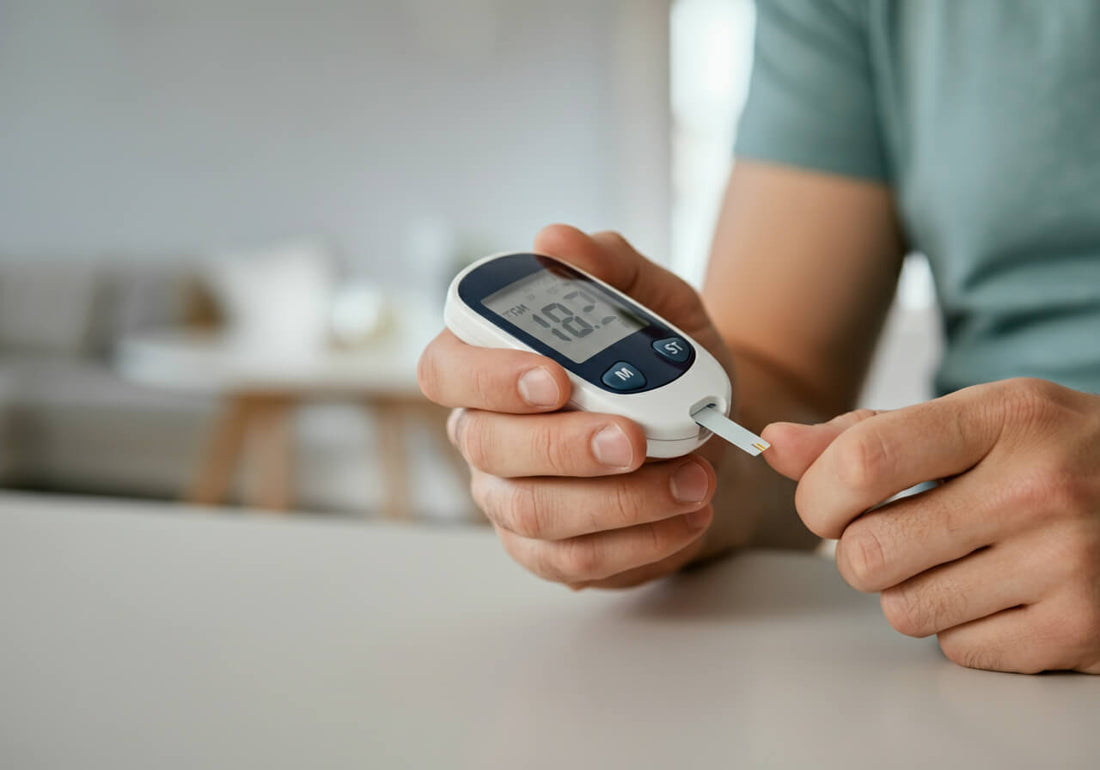How to Monitor Glucose Levels at Home
 Written By
Yusela Aquino
Written By
Yusela Aquino

Monitoring glucose levels at home is essential for managing health, particularly for individuals with diabetes or prediabetes. However, even those without diabetes can benefit from tracking glucose to optimize metabolic health. Understanding how different foods, exercise, and stress affect blood sugar can empower you to make informed decisions. This article will walk you through everything you need to know about home glucose monitoring, from interpreting readings to selecting the best devices.
Understanding Your Glucose Readings
A normal fasting blood glucose level ranges from 70 to 100 mg/dL, while post-meal readings should remain below 140 mg/dL two hours after eating. Readings above these ranges indicate hyperglycemia (high blood sugar), while levels below 70 mg/dL suggest hypoglycemia (low blood sugar).
If you frequently experience symptoms such as excessive thirst, frequent urination, fatigue (symptoms of high glucose), or dizziness, confusion, or sweating (symptoms of low glucose), consult a healthcare professional. Understanding these numbers helps you take proactive steps to maintain stable blood sugar levels.
How to Monitor Glucose Levels Accurately
To ensure accurate glucose monitoring, it’s important to use the correct techniques and tools. Below are the primary methods for tracking glucose at home.
Blood Glucose Meters (BGMs)
Blood glucose meters (BGMs) are the most common and reliable tools for checking glucose levels at home. They provide quick results using a small blood sample, making them essential for daily monitoring. To ensure accurate readings, follow these steps:
- Wash hands thoroughly. Dirt or food residue can alter results.
- Prepare supplies: Blood glucose meter, test strips, and a lancet.
- Prick the side of your fingertip with the lancet to obtain a small blood sample.
- Apply the blood drop to the test strip, and wait for the reading.
- Record results to track patterns over time.
Continuous Glucose Monitors (CGMs)
CGMs use a small sensor placed under the skin to continuously measure glucose levels, providing real-time data and alerts for highs and lows. These devices help detect patterns and trends, reducing the need for frequent finger pricks. CGMs are especially useful for individuals managing diabetes or those who want deeper insights into their glucose fluctuations.
Urine Glucose Testing

Although not as precise as blood glucose testing, urine glucose tests can indicate significantly high blood sugar levels, often used to detect ketones in cases of severe hyperglycemia.
For convenient at-home urine glucose monitoring, consider using Ribbon Checkup's Urine Test Kit. This easy-to-use kit provides quick insights into glucose levels, helping you track potential fluctuations and manage your health effectively. While not a replacement for blood testing, it serves as a useful supplementary tool.
How Often Should You Check Glucose Levels?
The frequency of glucose testing varies depending on individual health goals and conditions. Below are general guidelines:
- Diabetes: Before and after meals, physical activity, and during illness.
- Prediabetes: A few times per week, especially after meals.
- General Health Monitoring: Periodically to observe trends in response to diet and lifestyle changes.
Using Glucose Data to Improve Health
Tracking glucose patterns can provide valuable insights into your health. By analyzing your readings, you can:
- Identify foods that cause spikes.
- Adjust meal timing and composition.
- Optimize exercise for blood sugar control.
- Recognize the impact of stress and sleep on glucose levels.
Sharing data with healthcare providers can help personalize treatment plans and improve overall management.
Challenges of Home Glucose Monitoring
While home glucose monitoring is beneficial, there are some challenges to consider:
- Accuracy Issues: Incorrect technique, expired test strips, or calibration errors can affect readings.
- Cost and Accessibility: Not all devices are covered by insurance.
- Anxiety Around Readings: Monitoring should be approached as a tool for learning, not fear.
Being aware of these challenges can help you navigate glucose monitoring more effectively and confidently.
Misconceptions About Glucose Monitoring
There are several myths surrounding glucose monitoring. Here are some common misconceptions:
- Only diabetics need to check glucose: Anyone can benefit from understanding blood sugar patterns.
- A single high reading means diabetes: Occasional fluctuations are normal; patterns matter more.
- Non-invasive monitors are just as accurate: While convenient, most still lack the precision of BGMs and CGMs.
Take Control of Your Glucose Monitoring
Regular glucose monitoring provides critical insights into how your body responds to food, exercise, stress, and sleep. Understanding glucose patterns allows for informed lifestyle changes that can improve metabolic health, prevent complications, and support long-term wellness.
Whether you're managing diabetes, monitoring prediabetes, or optimizing overall health, selecting the right monitoring method is key. Blood glucose meters, CGMs, and urine glucose tests all serve valuable purposes. Ribbon Checkup's Urine Test Kit offers a convenient and effective way to supplement your glucose tracking routine, helping you gain a clearer picture of your metabolic health. Taking proactive steps today can help you manage your blood sugar earlier!
References:
Adu, M. D., Malabu, U. H., Malau-Aduli, A. E. O., & Malau-Aduli, B. S. (2019). Enablers and barriers to effective diabetes self-management: A multi-national investigation. PloS one, 14(6), e0217771. https://doi.org/10.1371/journal.pone.0217771
Blood glucose meters can play an important role in diabetes care | American Diabetes Association. (n.d.). https://diabetes.org/about-diabetes/devices-technology/blood-glucose-meters-important-role-in-diabetes-care
Blood sugar testing: Why, when and how. (n.d.). Mayo Clinic. https://www.mayoclinic.org/diseases-conditions/diabetes/in-depth/blood-sugar/art-20046628
Criteria for diagnosing Diabetes. (n.d.). https://myhealth.alberta.ca/Health/pages/conditions.aspx?Hwid=tj4293
Hyperglycemia: symptoms, causes, and treatments. (2023, November 1). Yale Medicine. https://www.yalemedicine.org/conditions/hyperglycemia-symptoms-causes-treatments
International Diabetes Federation. (2024, December 19). Continuous Glucose Monitoring (CGM) | International Diabetes Federation. https://idf.org/about-diabetes/continuous-glucose-monitoring/
Marsden, J., & Pickering, D. (2015). Urine testing for diabetic analysis. Community eye health, 28(92), 77.
National Health Services UK. (2023, August). Low blood sugar (hypoglycaemia). NHS. Retrieved February 1, 2025, from https://www.nhs.uk/conditions/low-blood-sugar-hypoglycaemia/ Seery, C. (2022, November 22). Normal and diabetic blood sugar level ranges. Diabetes. https://www.diabetes.co.uk/diabetes_care/blood-sugar-level-ranges.html
The cost of access to diabetes Technologies | American Diabetes Association. (n.d.). https://diabetes.org/tools-resources/managing-diabetes-costs/cost-access-diabetes-technologies
Wan, W., Skandari, M. R., Minc, A., Nathan, A. G., Winn, A., Zarei, P., O'Grady, M., & Huang, E. S. (2018). Cost-effectiveness of Continuous Glucose Monitoring for Adults With Type 1 Diabetes Compared With Self-Monitoring of Blood Glucose: The DIAMOND Randomized Trial. Diabetes care, 41(6), 1227–1234. https://doi.org/10.2337/dc17-1821

Yusela is a medical student with a degree in Biology and a strong foundation in health communication. With experience in both research and clinical settings, she writes clear, evidence-informed content to help patients and caregivers better understand liver health, chronic disease, and transplant care.



